Companion planting is a useful way to increase the diversity, pest resistance, and yield of your garden. It also helps reduce the need for weeding, and can help with pest prevention and disease avoidance. It’s also a preliminary step into permaculture and working with our natural environments and cycles instead of against them.
Companion planting with culinary and medicinal herbs can increase vegetable yields, improve the health of the soil, repel pests, and encourage beneficial soil micro-organisms that make soil nutrients more bioavailable to vegetables. Intentionally and strategically planting herbs near vegetables can make your vegetable garden grow better and increase your yields. Plus just planting some of these herbs near your garden can increase the biodiversity of your garden. You don’t need to plant a lot of companion herbs to make a big difference either. Just a few strategically placed companion plants can make a meaningful difference in the health of your plants and the yields from your garden.
What is companion planting?
Companion planting is using herbs or vegetables strategically next to other herbs and vegetables to cause beneficial results in both plants. The plants form a symbiotic relationship with each other that enhances the growth of both. Sometimes companion plants increase the minerals available in the root zone of their companions enhancing growth. Sometimes the companion has highly scented leaves or flowers that confuse plant pests, or attract predatory insects or birds that feed on plant pests. Other times the companion herb is a general tonic to the whole garden, as is the case with chamomile and calendula.
How to use companion planting strategically
To use companion planting strategically you need to understand what each companion plant offers to the garden and know which plants to plant them near. You don’t need a whole row of companion plants. A single dill plant within an area of 20 broccoli plants is enough to deter cabbage white butterflies. A basil plant growing at either end of a row of tomato plants is enough to enhance the flavor of the tomatos in the row. Many Mediterranean herbs that attract pollinators can be placed in the borders around the garden where they won’t be watered with the same schedule as the garden vegetables, thereby keeping them a little drier and happier. The key is to understand the needs of each of the companions and use them in the garden in a way that lets them be their best.
Where there was a definite pest problem in previous years, planting more companion plants that address the pest problem this season can help to bring the garden back into balance and increase biodiversity, without resorting to poisonous chemicals that harm both beneficial insects and pests. For instance where an apple tree suffered with codling moth or aphids last season, planting onions or chives in a circle around the trees, and then planting lavender in the rows between trees will help prevent a reoccurance.
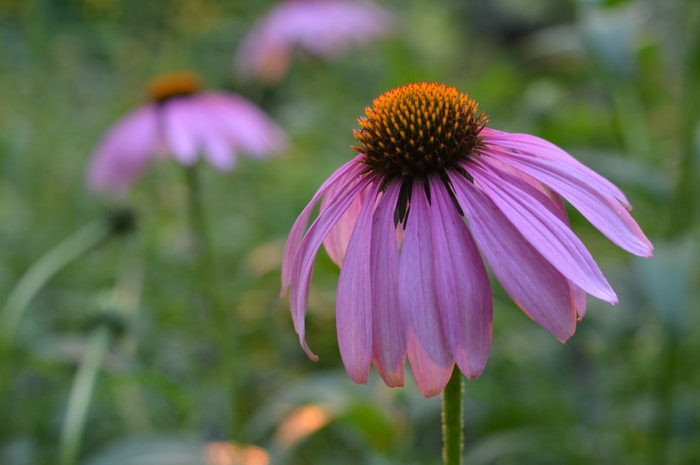
How to use herbs in companion planting
There are many herbs that can act as companion plants in your vegetable garden. Some attract beneficial insects to increase pollination and to predate pests. Others work in the root zone to enhance the bioavailability of nitrogen, phosphorus, and potassium by increasing beneficial soil microbes. Many of these companion herbs improve the health of soil and act as a tonic to the whole garden just as they are medicinal tonics in the herbal apothecary.
- Echinacea attracts beneficial insects to the garden that prey on insect pest.
- Plant basil with tomatoes, peppers, and eggplant to enhance their flavors.
- Nasturtium improves the flavor of tomatoes. It is attractive to aphids and is often used as a trap crop to capture them away from other plants. Nasturtium provides nectar for bees and other pollinators. Since it grows close to the ground it provides hiding spaces for spiders and predatory ground beetles.
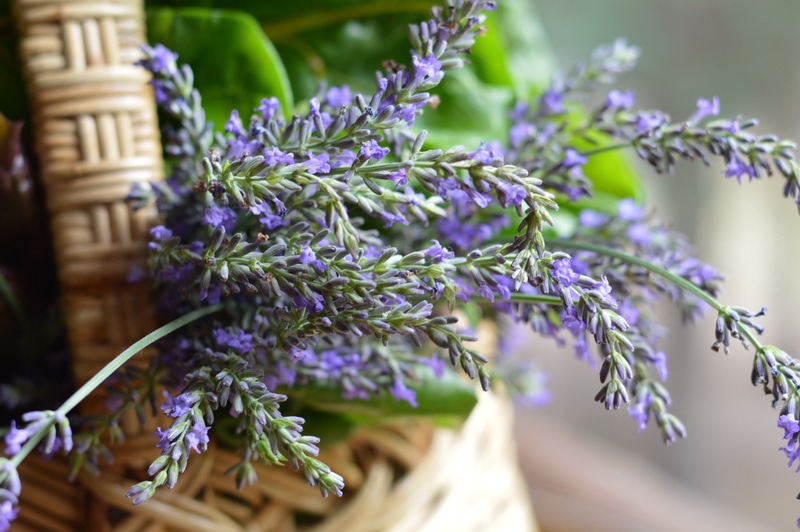
- Grow lavender with apple and pear trees. The strongly scented leaves and flowers repel codling moth and other caterpillars and moths. Bees and hummingbirds are attracted to lavender, too.
- Anise Hyssop attracts bees and other pollinators. Plant it a row away from your garden to act as a magnet for cabbage butterflies and keep them away from your cabbages, broccoli, and kale.
- Borage is beneficial with tomatoes and cabbage family plants. It deters tomato hornworm and cabbage butterflies. It attracts pollinators so plant it around squash, melons, and cucumber plants to increased pollination. Borage improves the soil and is good for the compost pile.

- Chives, garlic, Welsh or Egyptian Onions are companions for fruit trees, carrots, beets, strawberries, cabbage, and lettuce but avoid planting alliums near peas or beans. Allium plants repel carrot rust fly, aphids, and Japanese beetles, as well as fruit tree borers. Chives and Egyptian onions accumulate potassium and calcium in their leaves, making them a good choice for chop and drop fertilizer during the growing season. These two alliums will regrow after they are cut, and can be trimmed two or three times during the growing season.
- Thyme is a garden tonic herb. It enhances the flavor of strawberries and repels cabbage white butterflies from the broccoli bed. Thyme attracts hover flies which feed on aphids. But like other Mediterranean herbs it doesn’t like to have it’s feet wet, so plant it where it won’t get the weekly sprinkler rotation.
- Sunflowers enhance the growth of corn, maize, and popcorn. The ray flowers are rich food for pollinators. Sunflowers also attract hummingbirds which eat white flies, ants, aphids, mites, and mosquitoes. Plant them in the border as these tall plants can shade other crops in your garden.
Companion planting with umbellifers
Dill, fennel, lovage, cilantro, and parsley are examples of Umbelliferae or Apiaceae family plants that includes carrots, celery, and parsnip, as well as Queen Anne’s Lace. This family of plants is characterized by deep tap roots, hollow stems and flat topped florescence with scores of tiny, nectar-rich flowers forming the umbel on each stem. The nectar in these tiny flowers is very attractive to beneficial insects including both pollinators and predatory insects.
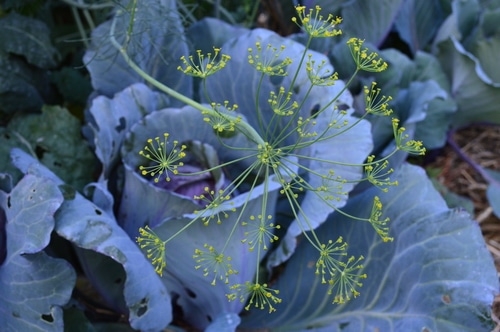
Lady bugs often hide between the tiny flowers. Predatory wasps, hover flies, lacewings, and other predatory insects are attracted by the nectar. These beneficial insects prey on caterpillars, aphids, and other pests in the garden. Just planting blooming umbellifers in the garden increases the biodiversity because of the nectar rich flowers. This balances the ecosystem and prevents critical infestations that destroy vegetable crops.
The umbelliferae family also attract swallow tail butterflies that lay their eggs on the branches. So leave a few stems in the garden to overwinter so that more of these beautiful butterflies can populate your garden.
There’s only one umbellifer that should NOT be planted in your vegetable garden. Fennel should be planted away from other vegetables. It inhibits their growth. Consider fennel a lone ranger and plant it on the outskirts of the garden away from other veggies and away from dill. Fennel and dill cause flavor-loss in each other. But fennel is such a good medicinal herb for colic and other tummy pains, that you should definitely have it in your herbal apothecary. Just plant it in a corner by itself.
Herbs with super powers for companion planting
The following herbs are beneficial companion plants throughout the garden. They bioaccumulate minerals in leaves and flowers. They attract pollinating insects as well as predatory insects. They also deter pests. Plant them freely throughout the garden and on the edges of the garden to improve the soil, to help other plants grow better, and to increase the biodiversity of insect and birdlife in your garden.
- Chamomile is a nurse plant to other plants. It accumulates potassium, calcium, and sulfur and returns it to the soil when it dies back. It attracts pollinators and beneficial insects. It sucks up nutrients like calcium, phosphorous, and potassium from deep in the soil and then adds them to the soil when it is used as mulch. When planted near other plants it improves vigor and yields. Chamomile, when planted near onions improves their flavor. Chamomile attracts parasitic wasps which feed on caterpillars, protecting plants from damage. Plant it near brassica family plants.

- Calendula is a tonic plant for the whole garden. Its roots form active relationships with soil microbes and beneficial fungi which helps the whole garden. The plant suppresses root nematodes in much the same way that marigolds do. The flowers are rich in nectar and resin making calendula a beneficial plant for pollinators offering medicine as well as food to bees. It attracts predatory insects that prey on garden pests. It is another plant that accumulates minerals in its leaves. Calendula is also used on land as a mop up for dangerous levels of cadmium– however when used for this service it should not be composted nor used as food or medicine, since the cadmium will remain in the leaves and flowers.

- Yarrow is from the Asteraceae family, but like the Umbelliferae family plants its mass of tiny flowers form umbel shaped florescence. Like the Umbelliferae plants yarrow is very attractive to pollinators and predatory insects like ladybugs, and lacewings. Yarrow also bioaccumulates copper, potassium, and phosphorous and when used as a mulch or allowed to break down in the soil, it adds these nutrients to the soil.
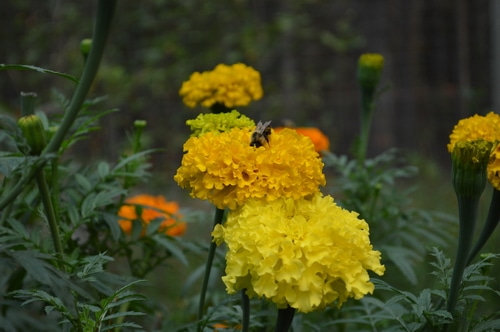
- Marigolds are strongly scented and kill root nematodes that can damage vegetable crops and flowers. Chop them and drop them on the soil surface at the end of the season or dig them into the garden once the flowers have faded with frost. The flowers of Aztec Marigold are high in lutein and zeaxanthin, two important antioxidant flavinoids for eye health. So save the flowers for medicinal use when you compost the plants at the end of the season.
- Comfrey should be planted outside the vegetable garden in a spot reserved for it. It spreads through root pieces and will shade other plants if planted directly in the garden. It is beneficial as a cut and come again mulch, as it bioaccumulates minerals in it’s leaves that are beneficial to other plants. It can be cut back two or three times during the growing season. I like to leave a few comfrey plants to flower though, as it will flower continuously until frost giving nectar to bumble bees and other native pollinators.
- Monarda or Bee Balm is attractive to beneficial insects and also attracts hummingbirds. The hummingbirds devour garden pests like white flies, ants, aphids, gnats, mites, and mosquitoes. Monarda improves the flavor of tomatoes.
- Clover is a nitrogen fixer and helps to build the soil. Clover accumulates phosphorous, as well as nitrogen in it’s leaves. It blooms all season long and is attractive to pollinators and predatory insects as well as honeybees. It repels cabbage butterflies. Planting it under fruit trees and in garden walk ways allows the nitrogen to filter to nearby garden beds.
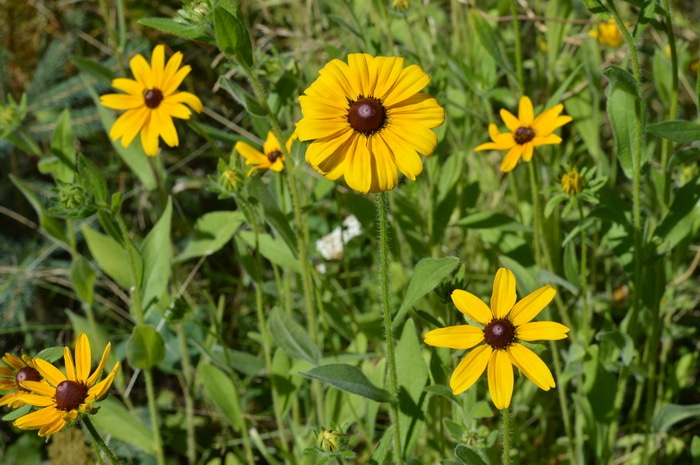
- Rudbekia or Black Eyed Susan is attractive to pollinators and predatory insects. From the same family as echinacea, it forms beneficial relations with soil micro-organisms, improving that whole garden. Plant it on the edges as it self sows freely.
Companion planting and its relationship to permaculture systems
One of the best systems of companion planting is the permaculture system.
Permaculture is a system for designing agricultural landscapes hat work with nature instead of against it. I like to call it edible restoration, since the tools used in permaculture can help to restore the land as well as yield food for humans…[permaculture is] an approach for growing food efficiently with ecological integrity. — Amy Stross, Suburban Micro Farm
I recently read the book Suburban Micro Farm, Modern Solutions for Busy People by Amy Stross. I reviewed the book here, but in the connection of talking about the importance of companion planting I wanted to mention it again. If you are just getting started with gardening and companion planting rather than taking a superficial look and merely grabbing a basil to plant beside your tomato plant, it would be well worth your time to dig a little deeper into the ultimate companion planting guide found in permaculture design.
Permaculture helps you grow more food, on less land with less work because it works with nature, enhancing soil microbes, increasing biodiversity, and mimicking natural systems, that increase soil fertility and yields. I found Amy Stross’ book to be invaluable in understanding how permaculture works and how to apply the principles of permaculture to a small holding.
This full-color edition of Amy Stross’ book is distributed by Chelsea Green (2017) and available on Amazon. It is the urban gardener’s guide to using permaculture principles on a small scale to reduce the work and increase the enjoyment and the yields of your garden. One of the key features of permaculture is using companion planting to increase biodiversity, fertility, and yields in meaningful and strategic ways.
You can grab your own copy of the Amy’s book here.
Disclosure: I received an advanced reading copy of this book from Chelsea Green Publishers in order to offer an honest review of the work.


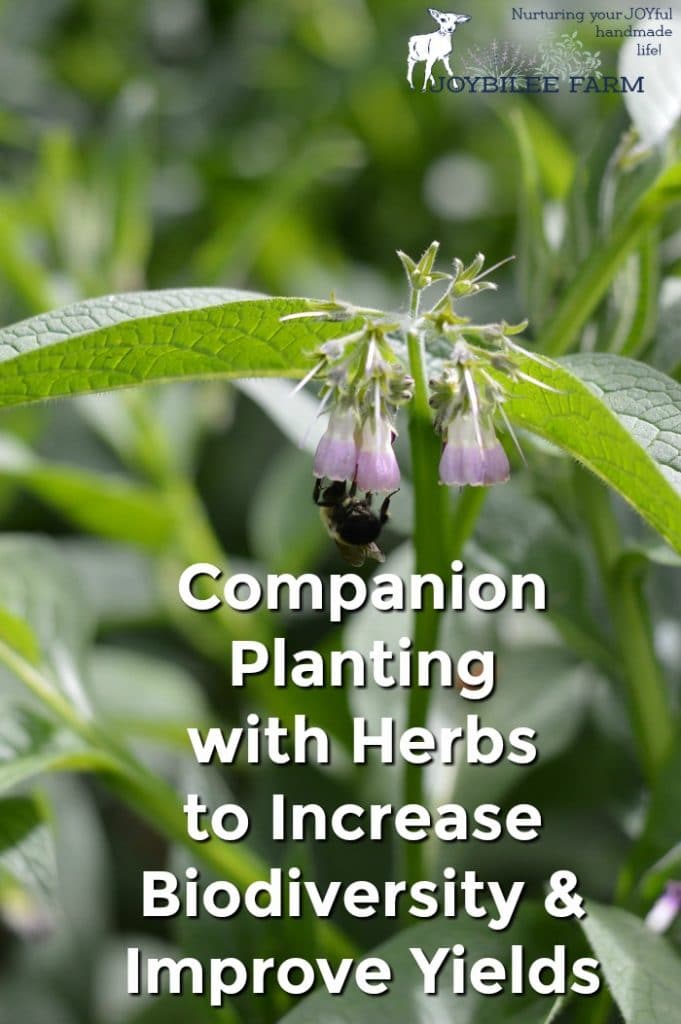
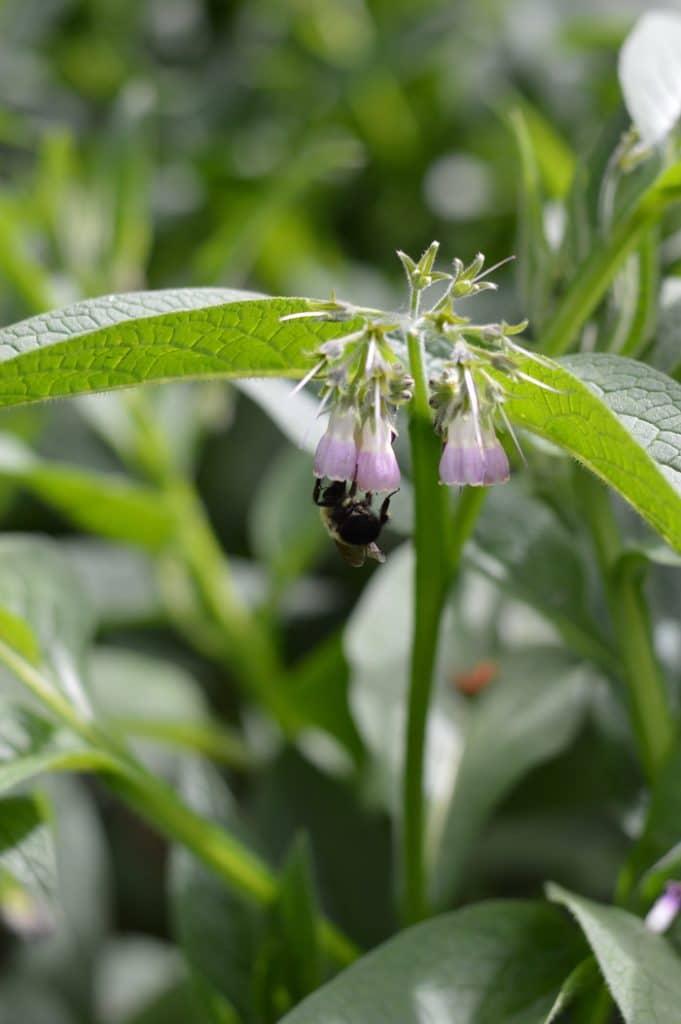
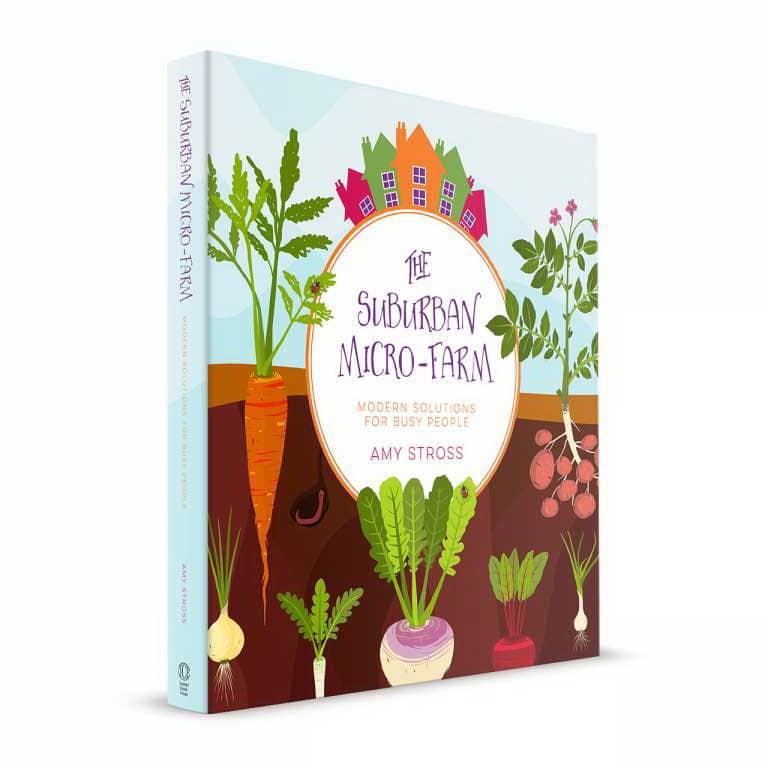


Thank you so much, Candace, for your kind words. This made my day!
Chris and Sarah, thank you for this excellent article! I have learned so much from the education you provide in emails and on your website, and, as a result, my garden thrives. I live in Whitefish, MT and with a short growing season this is not always easy. There’s so much garden info to learn, be aware of and put into practice!
I look forward to your email posts which inevitably lead to at least one trip to your website–it’s fantastic in every way and extremely helpful to me. Too bad there isn’t an academy award for garden information–you’d win it hands down!
I have had some comfrey olanted for sevberal years and it has not spread I have been told to plant it away from the garden and so I did that but it hasn’t spread at all it is a nice plant but no other plants are coming up from it what do I need to do to get it to spread?